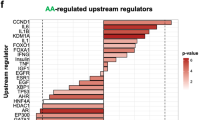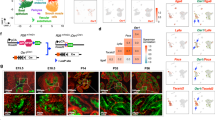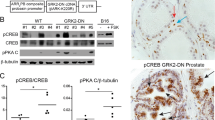Abstract
Prostate cancer mortality is primarily due to failure to cure patients with metastatic disease. In its early stages, prostate cancer growth is enhanced by androgens. As such, the primary therapy for advanced (locally extensive or metastatic) prostate cancer consists of androgen deprivation therapy by pharmacotherapeutic or surgical means. Eventually, the tumor recurs owing to a transition from androgen-dependence to a highly metastatic and androgen refractory (androgen depletion-independent) phenotype. As the detailed molecular mechanism underlying this transition to a more aggressive phenotype is poorly understood, it has been difficult to develop effective treatments for this advanced stage of the disease. We have previously reported an increase in vascular endothelial growth factor-C (VEGF-C) expression in human prostate cancer cells after androgen withdrawal. We have also shown increased expression of the androgen receptor co-activator BAG-1L by VEGF-C, suggesting the involvement of this growth factor in transactivation of the androgen receptor, even at low concentrations of androgen. In our present study, we show that androgen deprivation of human prostate carcinoma cells activates the small GTPase, RalA, a molecule important for human oncogenesis. RalA activation leads to VEGF-C upregulation. We also show that elevated levels of intracellular reactive oxygen species in prostate cancer cells under androgen-ablated conditions is the major inducer of RalA activation and VEGF-C synthesis.
This is a preview of subscription content, access via your institution
Access options
Subscribe to this journal
Receive 50 print issues and online access
$259.00 per year
only $5.18 per issue
Buy this article
- Purchase on Springer Link
- Instant access to full article PDF
Prices may be subject to local taxes which are calculated during checkout







Similar content being viewed by others
References
Chardin P, Tavitian A . (1986). The ral gene: a new ras related gene isolated by the use of a synthetic probe. EMBO J 5: 2203–2208.
Chien Y, White MA . (2003). RAL GTPases are linchpin modulators of human tumour-cell proliferation and survival. EMBO Rep 4: 800–806.
Collette J, Ulku AS, Der CJ, Jones A, Erickson AH . (2004). Enhanced cathepsin L expression is mediated by different Ras effector pathways in fibroblasts and epithelial cells. Int J Cancer 112: 190–199.
de Ruiter ND, Wolthuis RM, van Dam H, Burgering BM, Bos JL . (2000). Ras-dependent regulation of c-Jun phosphorylation is mediated by the Ral guanine nucleotide exchange factor-Ral pathway. Mol Cell Biol 20: 8480–8488.
Denis L, Murphy GP . (1993). Overview of phase III trials on combined androgen treatment in patients with metastatic prostate cancer. Cancer 72: 3888–3895.
Epstein JI, Partin AW, Sauvageot J, Walsh PC . (1996). Prediction of progression following radical prostatectomy. A multivariate analysis of 721 men with long-term follow-up. Am J Surg Pathol 20: 286–292.
Essers MA, Weijzen S, de Vries-Smits AM, Saarloos I, de Ruiter ND, Bos JL et al. (2004). FOXO transcription factor activation by oxidative stress mediated by the small GTPase Ral and JNK. EMBO J 23: 4802–4812.
Feig LA . (2003). Ral-GTPases: approaching their 15 minutes of fame. Trends Cell Biol 13: 419–425.
He Y, Kozaki K, Karpanen T, Koshikawa K, Yla-Herttuala S, Takahashi T et al. (2002). Suppression of tumor lymphangiogenesis and lymph node metastasis by blocking vascular endothelial growth factor receptor 3 signaling. J Natl Cancer Inst 94: 819–825.
Isaacs JT . (1999). The biology of hormone refractory prostate cancer. Why does it develop? Urol Clin North Am 26: 263–273.
Jennbacken K, Vallbo C, Wang W, Damber JE . (2005). Expression of vascular endothelial growth factor C (VEGF-C) and VEGF receptor-3 in human prostate cancer is associated with regional lymph node metastasis. Prostate 65: 110–116.
Jia YT, Li ZX, He YT, Liang W, Yang HC, Ma HJ . (2004). Expression of vascular endothelial growth factor-C and the relationship between lymphangiogenesis and lymphatic metastasis in colorectal cancer. World J Gastroenterol 10: 3261–3263.
Karpanen T, Egeblad M, Karkkainen MJ, Kubo H, Yla-Herttuala S, Jaattela M et al. (2001). Vascular endothelial growth factor C promotes tumor lymphangiogenesis and intralymphatic tumor growth. Cancer Res 61: 1786–1790.
Kimura Y, Watanabe M, Ohga T, Saeki H, Kakeji Y, Baba H et al. (2003). Vascular endothelial growth factor C expression correlates with lymphatic involvement and poor prognosis in patients with esophageal squamous cell carcinoma. Oncol Rep 10: 1747–1751.
Kyprianou N, English HF, Isaacs JT . (1990). Programmed cell death during regression of PC-82 human prostate cancer following androgen ablation. Cancer Res 50: 3748–3753.
Li J, Wang E, Rinaldo F, Datta K . (2005). Upregulation of VEGF-C by androgen depletion: the involvement of IGF-IR-FOXO pathway. Oncogene 24: 5510–5520.
Lo YY, Wong JM, Cruz TF . (1996). Reactive oxygen species mediate cytokine activation of c-Jun NH2-terminal kinases. J Biol Chem 271: 15703–15707.
Mandriota SJ, Jussila L, Jeltsch M, Compagni A, Baetens D, Prevo R et al. (2001). Vascular endothelial growth factor-C-mediated lymphangiogenesis promotes tumour metastasis. EMBO J 20: 672–682.
McFall A, Ulku A, Lambert QT, Kusa A, Rogers-Graham K, Der CJ . (2001). Oncogenic Ras blocks anoikis by activation of a novel effector pathway independent of phosphatidylinositol 3-kinase. Mol Cell Biol 21: 5488–5499.
Neuchrist C, Erovic BM, Handisurya A, Fischer MB, Steiner GE, Hollemann D . (2003). Vascular endothelial growth factor C and vascular endothelial growth factor receptor 3 expression in squamous cell carcinomas of the head and neck. Head Neck 25: 464–474.
Oh WK, Kantoff PW . (1998). Management of hormone refractory prostate cancer: current standards and future prospects. J Urol 160: 1220–1229.
Pettaway CA, Pathak S, Greene G, Ramirez E, Wilson MR, Killion JJ . (1996). Selection of highly metastatic variants of different human prostatic carcinomas using orthotopic implantation in nude mice. Clin Cancer Res 2: 1627–1636.
Sipos B, Klapper W, Kruse ML, Kalthoff H, Kerjaschki D, Kloppel G . (2004). Expression of lymphangiogenic factors and evidence of intratumoral lymphangiogenesis in pancreatic endocrine tumors. Am J Pathol 165: 1187–1197.
Skobe M, Hawighorst T, Jackson DG, Prevo R, Janes L, Velasco P et al. (2001). Induction of tumor lymphangiogenesis by VEGF-C promotes breast cancer metastasis. Nat Med 7: 192–198.
Tam NN, Gao Y, Leung YK, Ho SM . (2003). Androgenic regulation of oxidative stress in the rat prostate: involvement of NAD(P)H oxidases and antioxidant defense machinery during prostatic involution and regrowth. Am J Pathol 163: 2513–2522.
Tchevkina E, Agapova L, Dyakova N, Martinjuk A, Komelkov A, Tatosyan A . (2005). The small G-protein RalA stimulates metastasis of transformed cells. Oncogene 24: 329–335.
Tsurusaki T, Kanda S, Sakai H, Kanetake H, Saito Y, Alitalo K et al. (1999). Vascular endothelial growth factor-C expression in human prostatic carcinoma and its relationship to lymph node metastasis. Br J Cancer 80: 309–313.
Ulku AS, Schafer R, Der CJ . (2003). Essential role of Raf in Ras transformation and deregulation of matrix metalloproteinase expression in ovarian epithelial cells. Mol Cancer Res 1: 1077–1088.
Urano T, Emkey R, Feig LA . (1996). Ral-GTPases mediate a distinct downstream signaling pathway from Ras that facilitates cellular transformation. EMBO J 15: 810–816.
Zeng Y, Opeskin K, Horvath LG, Sutherland RL, Williams ED . (2005). Lymphatic vessel density and lymph node metastasis in prostate cancer. Prostate 65: 222–230.
Acknowledgements
We thank Dr Donald Tindall and Dr Debabrata Mukhopadhyay for their helpful discussion. This work was partly supported by a Career Development project in prostate SPORE grant (Mayo Clinic) (1 PSOCA91956-3) and a New Investigator award grant from US Army Medical Research and Material Command (2B1636) of KD.
Author information
Authors and Affiliations
Corresponding author
Additional information
Supplementary Information accompanies the paper on the Oncogene website (http://www.nature.com/onc).
Supplementary information
Rights and permissions
About this article
Cite this article
Rinaldo, F., Li, J., Wang, E. et al. RalA regulates vascular endothelial growth factor-C (VEGF-C) synthesis in prostate cancer cells during androgen ablation. Oncogene 26, 1731–1738 (2007). https://doi.org/10.1038/sj.onc.1209971
Received:
Revised:
Accepted:
Published:
Issue Date:
DOI: https://doi.org/10.1038/sj.onc.1209971
Keywords
This article is cited by
-
Involvement of RhoA and RalB in geranylgeranyltransferase I inhibitor-mediated inhibition of proliferation and migration of human oral squamous cell carcinoma cells
Cancer Chemotherapy and Pharmacology (2011)
-
HIF1α isoforms in benign and malignant prostate tissue and their correlation to neuroendocrine differentiation
BMC Cancer (2010)
-
Gender dimorphism of tumor growth: role of gonadal hormones in differential regulation of apoptosis of a murine T cell lymphoma
Journal of Biomedical Science (2008)



